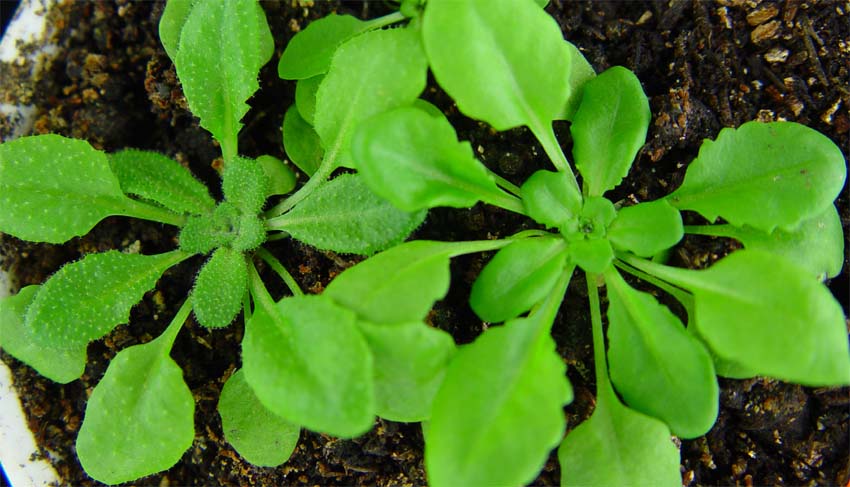北大邓兴旺组在PLOS子刊发文揭示UV-B光信号转导机制

UVR8蛋白是近年来新鉴定出的植物UV-B光受体。不同于具有外源生色团的其他光受体,UVR8利用自身的色氨酸作为生色团。在无UV-B光照时,UVR8依靠以精氨酸R286和R338为中心的分子间氢键形成稳定的同源二聚体;UVR8色氨酸W233和W285行使内源生色团的功能。当接受UV-B光照时,这两个色氨酸的吲哚环电子被激发,破坏了它们与相邻精氨酸之间的电荷作用,影响了R286和R338在二聚体结构中的稳定性,从而破坏了同源二聚体分子间的相互作用而产生单体。然而,此前拟南芥UVR8如何基于这些结构特性在植物体内感受UV-B光信号并完成下游信号转导不得而知。
邓兴旺实验室通过构建一系列拟南芥内源UVR8突变型蛋白以及系统的生理生化分析,发现UVR8蛋白的构象变化并不足以促使植物进行UV-B光信号转导,揭示了UVR8单体与COP1蛋白形成复合体的多少是决定植物对UV-B光信号的敏感性的关键因素。该项工作是邓兴旺实验室在前期研究基础上(Huang et al., 2012; Huang et al., 2013)对植物UV-B光信号转导研究的深入探索,进一步揭示了UVR8光受体的复合体组成在UV-B信号转导中的核心地位。
此外,该项工作发现了两个在植物体内具有组成型活性的UVR8变异体UVR8W285A与UVR8R338A能够不依赖于光完成组成型光形态建成的发育过程。目前,UVR8蛋白的生化特性已引起生物技术领域的广泛关注,被改良应用于光调控蛋白质互作、光诱导基因表达等动物实验体系。因此,该项工作亦为UVR8蛋白应用于非植物源体系的蛋白质工程研究提供了科学借鉴。
该项工作的第一作者为邓兴旺实验室的博士后黄烯,与湖南师范大学联合培养的博士研究生杨盼宇是本文的共同第一作者,邓兴旺实验室的欧阳鑫昊博士与湖南师范大学的陈良碧教授也做出了重要贡献。该项工作得到了国家自然科学基金委、北京大学蛋白质与植物基因研究国家重点实验室、中国博士后科学基金、北大-清华生命科学联合中心等的大力支持。
原文摘要:
Photoactivated UVR8-COP1 Module Determines Photomorphogenic UV-B Signaling Output in Arabidopsis
Xi Huang, Panyu Yang, Xinhao Ouyang, Liangbi Chen, Xing Wang Deng
In Arabidopsis, ultraviolet (UV)-B-induced photomorphogenesis is initiated by a unique photoreceptor UV RESISTANCE LOCUS 8 (UVR8) which utilizes its tryptophan residues as internal chromophore to sense UV-B. As a result of UV-B light perception, the UVR8 homodimer shaped by its arginine residues undergoes a conformational switch of monomerization. Then UVR8 associates with the CONSTITUTIVELY PHOTOMORPHOGENIC 1-SUPPRESSOR OF PHYA (COP1-SPA) core complex(es) that is released from the CULLIN 4-DAMAGED DNA BINDING PROTEIN 1 (CUL4-DDB1) E3 apparatus. This association, in turn, causes COP1 to convert from a repressor to a promoter of photomorphogenesis. It is not fully understood, however, regarding the biological significance of light-absorbing and dimer-stabilizing residues for UVR8 activity in photomorphogenic UV-B signaling. Here, we take advantage of transgenic UVR8 variants to demonstrate that two light-absorbing tryptophans, W233 and W285, and two dimer-stabilizing arginines, R286 and R338, play pivotal roles in UV-B-induced photomorphogenesis. Mutation of each residue results in alterations in UV-B light perception, UVR8 monomerization and UVR8-COP1 association in response to photomorphogenic UV-B. We also identify and functionally characterize two constitutively active UVR8 variants, UVR8W285A and UVR8R338A, whose photobiological activities are enhanced by the repression of CUL4, a negative regulator in this pathway. Based on our molecular and biochemical evidence, we propose that the UVR8-COP1 affinity in plants critically determines the photomorphogenic UV-B signal transduction coupling with UVR8-mediated UV-B light perception.
标签: 信号转导 拟南芥 UV-B光 UVR8突变型蛋白
作者:北京大学

